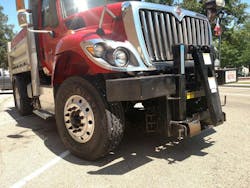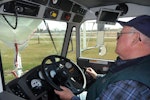For motorists to remain mobile and commerce to flow, snow plow trucks go into operating mode and work around the clock keeping roads open. These are highly specialized vehicles, and while most of them are fitted with dump bodies, a glance at one of them reveals that it carries far more in equipment than the typical dump truck, especially at its front end. That’s the mount for snow plow equipment, and even without a blade in place, the mount is massive and must be properly supported. If a truck is to be fitted with an additional wing or belly blade, further reinforcements are in order. The dump body carries devices on its tail gate to spread salt and sand, and in warm months might transport dirt, gravel, and other materials used in road and bridge building and maintenance.
Most dump truck snow plows are bought and operated by state departments of transportation and local municipalities, including cities, counties, villages, and townships. They keep such trucks for many years, and expect them to start and go when needed. They purchase vehicles and equipment on a bid basis, sometimes through cooperative arrangements where small orders are combined for better pricing. Ruggedness, reliability, long life, and a competitive price are the requirements. Snow plow trucks might look alike, but vary in many details depending on buyers’ preferences and operating needs, according to Bruce Vasbinder, director of product marketing for severe service, and Brent Bott, a vocational trucks engineer, at Navistar International, which earns much of this business.
First, as with any truck, the original equipment manufacturer needs to know exactly how the dump truck snow plow will be used, and any preferences a buyer might have. This includes the type and brand of snow plow equipment to be installed. Dealer sales people determine this during the ordering process; customers might prefer certain shops and products, but dealers also have relationships with body builders in their areas and smaller customers might accept recommendations. The OEM’s engineers review the specifications submitted with an order, and sometimes question and modify them in conferences with the buyer and his chosen body builder.
Snow plow truck types
Most plow trucks are conventional-cab types, but some municipalities use low cabovers whose primary duties are far removed from plowing. New York City, Chicago, and Milwaukee equip their trash-collection trucks with plow mounts and controls, and when a serious storm hits, they return to their garages, hook up plow blades, and hit the streets to push snow aside. Usually trash in their packer bodies stays on board to provide ballast to drive-axle wheels for good traction. This practice adds weight and complexity to a trash truck that is a negative for everyday operations. But like a dump truck that works in road maintenance during warmer weather, the trucks’ owners gain double duty from them.
Aside from the front plow, which will vary in size and mounting and operating equipment, a truck running in high-snowfall areas might also use wing and/or belly plows. Most vehicles operate individually and sometimes in “gang plowing,” partnering with additional trucks to clear wide roadways in one pass. In a few areas, a truck might pull a plow trailer, also called a pull plow, that can clear a lane to the right of the one the truck itself is plowing; this is especially true in Missouri, where the special trailers are built. More power and torque from the engine, higher capacity driveline components, and a higher gross combination weight rating are needed for this.
In all plow trucks, the frame is sized to handle shock as the plow drags along pavement and hits the bumps in it. Plows and mounts are built to withstand this, and so is the truck’s frame. In the past, reinforcements—inserts or “outserts” —were used, but experience showed that salt penetrates the gaps between the steel members and causes corrosion, sometimes “rust jacking” them apart. The practice now is to use larger rails without reinforcers.
How to prepare a chassis for snow plow trucks
Meanwhile, the frame should be arranged to accommodate snow plow equipment to be installed later. Sometimes a frame is cleared for belly and wing plows, primarily by moving the exhaust system, battery box, and fuel and DEF tanks to other locations. If the OEM doesn’t do it at the factory, the upfitter must handle it, and that costs more in time and money. The upfitter installs mounts for mid-frame plows, along with controls and wiring. Again, the truck’s wiring harness should include electrical hookups so the controls can be simply plugged in and in-cab switches programmed to operate them. Usually the upfitter also installs dedicated controls for the plow, body, and deicing equipment, all inside the cab.
If a front engine power take-off is used, frames can be extended forward of the grille to support the associated PTO equipment. Electrical hookups for plow lights are included in the wiring harness so the lights can be simply plugged in. The light switch in the cab will illuminate the plow lights while turning off the headlamps so they don’t reflect off the rear of the plow.
Plows on pickup trucks
A high-capacity front axle and suspension handle the weight of the plow mount and blade. Together they weigh 3 to 4 tons or more in medium- and heavy-duty chassis, so front ends are rated at 16,000 to 23,000 pounds. Wheels and tires are sized accordingly, with heavier axles carrying 385- or 425-series tires. Often dual power steering gear is used to swing the wheels.
Of course the builder’s application engineers also need to know who the body builder is so they can confer with their counterparts there. Once off the line, the bare truck is shipped to the proper place for upfitting. Major makers of snow plow equipment include Godwin, Hendrickson, J&J, Monroe, and Viking, who sell their products through distributors around the country, Bott and Vosbinder say. There are also smaller regional and local manufacturers. Customers try to use local shops but a lot of those are distributors for the larger builders. Then the completed truck goes to the selling dealer who does final prep work and delivers it to the customer, and you’ll see it on streets and roads.







